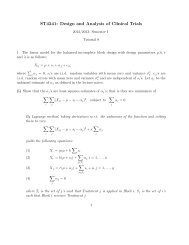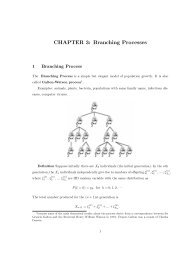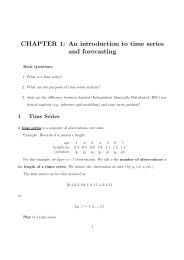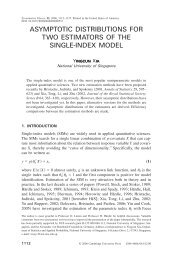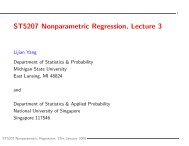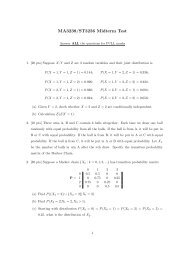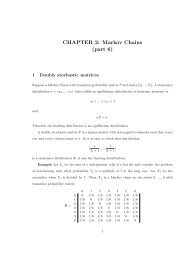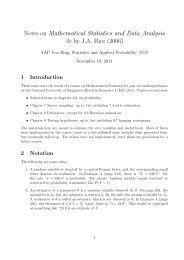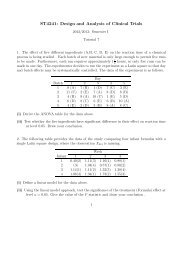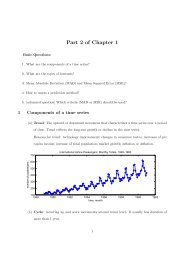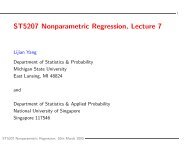ST5212: Survival Analysis
ST5212: Survival Analysis
ST5212: Survival Analysis
Create successful ePaper yourself
Turn your PDF publications into a flip-book with our unique Google optimized e-Paper software.
<strong>ST5212</strong>: <strong>Survival</strong> <strong>Analysis</strong><br />
2008/2009: Semester II<br />
Tutorial 2<br />
1. A model for lifetimes, with a bathtub-shaped hazard rate, is the exponential power distribution<br />
with survival fumction<br />
S(x) =exp{1 − exp[(λx) α ]}.<br />
(a) If α =0.5, show that the hazard rate has a bathtub shape and find the time at which the<br />
hazard rate changes from decreasing to increasing.<br />
(b) If α = 2, show that the hazard rate of x is monotone increasing.<br />
2. The Gompertz distribution is commonly used by biologists wh obelieve that an exponential<br />
hazard rate should occur in nature. The survival function of the Gompertz distribution is given<br />
by<br />
S(x) =exp{ θ α (1 − eαx )}.<br />
Suppose that the time to death in months for a mouse exposed to a high dose of radiation<br />
follows a Gompertz distribution with θ =0.01 and α =0.25. Find<br />
(a) the probability that a randomly chosen mouse will live at least one year,<br />
(b) the probability that a randomly chosen mouse will die within the first six months, and<br />
(c) the median time to death.<br />
3. The time to relapse, in months, for patients on two treatments for lung cancer is compared<br />
using the following log normal regrewssion model:<br />
Y =lnX =2+0.5z +2W,<br />
where W has a standard normal distribution and Z = 1 if treatment A and 0 if treatment B.<br />
(a) Compare the survival probabilities of the two treatments at 1, 2, and 5 years.<br />
1
(b) Repeat the calculations if W has a standard logistic distribution. The survival funciton of<br />
the standard logistic distribution is as follows:<br />
S(x) = 1<br />
1+e . x<br />
Compare your results with part (a).<br />
4. A model used in the construction of life tables is a piecewise, constant hazard rate model.<br />
Here the time axis is divided into k intervals, [τ i−1 ,τ i ),i =1,...,k, with τ 0 =0andτ k = ∞.<br />
The hazard rate on the ith interval is a constant value, θ i ;thatis<br />
⎧<br />
θ 1 0 ≤ x
6. Suppose that the joint survival function of the latent failure times for two competing risks,<br />
X and Y ,is<br />
S(x, y) =(1− x)(1 − y)(1 + 0.5xy), 0



